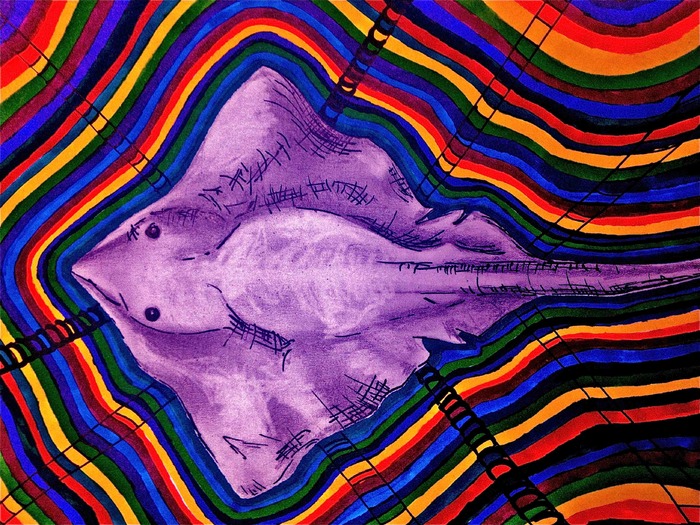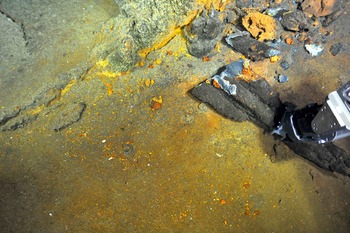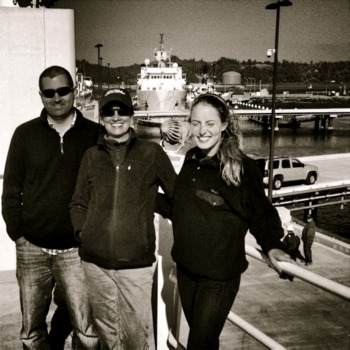28 July 2013
So, today was a very, very big day.
I am actually writing this July 30th because I literally stayed up all day yesterday. I was awakened by Nancy with “Montgomery, we are at International District!” I was excited about this, as my entire project is centered on hydrothermal vents and the biota found in and around them. So I popped out of bed and scurried up to the ROPOS control room.
When I walked in, we were at the vent Castle, the one I drew from a mosaic at the beginning of the cruise. The vent was even more gorgeous on the live video picked up by ROPOS than I possibly could have imagined. Who knew filamentous bacteria could add such a romantic aura to a piece of rock a mile beneath the sea surface? Marisa and Owen collected some lovely screen grabs and DSC shots of the vents (thanks, y’all) and I downloaded them to use in my presentations. As the ROV was flying around International District, they found a piece of extinct vent that had fallen of a larger vent structure. It was comprised of vividly colored rock, which definitely caught my eye. John asked if we could collect this as a sample, and I was beside myself with happiness.
Yes, I know what you’re thinking. I realize it may be just a rock to you. But clearly, it is not just a rock to me. And I’ll get on my soapbox as to why. Deep-sea hydrothermal vents are a relatively new scientific find and little is known about them. I personally can’t name many people outside of those on this research vessel right now who know a whole lot about them, which is why I am so interested in learning more about the physics, chemistry, biology, and geology behind them. Their composition as a hydrothermally altered, sulfide rock is amazing, situated in a sea of mid-ocean ridge basalt. People have created some intriguing hypotheses as to their existence, as well as their significance in our planetary atmosphere. And I was about to see a large chunk of vent, in the flesh as it were, on this ship. Thank you, University of Washington.
The rock was brought into the chemistry lab like a 100-pound baby swaddled in cloth. We stared at it for a while, and then preceded to take pictures of it like it was the Paris Hilton of the ocean depths. Anyway, it was totally love at first sight for me. I couldn’t believe that I could actually get a sample of this rock to take back to Charleston and run a series of tests on the specimen. I will be the envy of my classmates. The sample will be a fabulous supplement to my Bachelor’s Essay, and an interesting rock to show to students when I’m giving presentations.
25 July 2013
Today we had a science meeting to discus some of the tasks yet to complete on this leg of the cruise. Hard to believe we are almost halfway through… the days are going by faster and faster.
This is a list of some of the tasks we have yet to accomplish, but hope to accomplish, before we head back to Newport.
-Dive 1615 (lay and test cable (RS03W7) from PN3B to ASHES
-Recover ROCLS
-Dive 1616 Lay and test cable (RS0W70) from PN3B to Ashes
-Post-lay survey of both long cables
-Return to Ashes, recover ROCLS. End dive (end mid-day tmrw; July 26, 2013)
-Dive 1617, deploy seismometers (short period seismometer connected to the south and north end of ECAL###)
-Select location bet BOTPT near MJ03E
-Dive 1619, 1620, 1621 ALL in international district
There are a lot of letters and numbers in there, but they are all very crucial, as they correspond to different areas where we need to lay cable and install instruments. The final site we will be visiting before journeying home is the International District, which is a very active hydrothermal field. We haven’t visited this area since 2011, so it is important to do surveys and make careful decisions before installing different packages of instruments. For example, we don’t want to install a package on top of a 300 degree C hydrothermal vent, because that wouldn’t bode well for the package. Also, with active volcanism the hydrothermal fields are ever changing, so you never know quite what they will look like until you get down there with the ROV.
Watches have become more and more exciting, as we have become accustomed to many of the letters and numbers. It’s great to finally start to understand some of the engineering language as a science student on the ship.
Over and out! Time to watch “The Princess Bride” with some other students!
23 July 2013
23:20
Today I worked primarily on my hydrothermal vent project. It’s been fun putting together some of the incredible images and video of vents and biota we’ve obtained through these cruises. After working on my project for a while, I decided to give the on-ship gym a whirl. I got on the treadmill, only to find that walking was a bit more complicated when you are on a ship that is constantly heaving, yawing, pitching, and rolling. I essentially clung to the handrails on the treadmill for dear life, while only going a moderate speed. The kicker was when I dropped my Ipod, forgot the tread was still moving, and fell off the back of the treadmill. Needless to say, I don’t think I’ll be going to the ship gym again anytime soon, or at least until I get adequate sea-legs.
After my little gym adventure, I walked on deck and was struck by the number of albatross floating calmly in the water just off the fantail. One got spooked and glided across the water, and I came to realize how big their wingspans are. They are pretty amazing creatures in that they can exist so far from land and they are just so massive.
Tonight Owen talked to us about patchiness in the ocean between organisms and their food sources. He explained that some of the sources for patchiness in the ocean could be attributed to eolian deposition, river plumes, flow divergence, instabilities in density, and/ or sexual-selective behavior. For example, fish congregate in a school as a behavior, and albatross feed on that school; thus, they are attracted to this “patch” in the ocean, and therefore, the birds are a patch of predators, including albatross, but maybe dolphins too. There were several formulas he used to display this concept, with variables such as:
R= concentration of resource in patch
L=length scale ~ avg. distance between patches
And, of course, the variable of general time, which constricts us all… not to get too philosophical or anything.
Speaking of time, I had to miss the remainder of Owen’s talk because I had 4 hours of watch. Watch was interesting tonight, to say the least. We surveyed the length of the cable from the flange box to the secondary node. From a geological perspective, we saw a ton of beautiful basaltic features, including lava whorls, collapsed features, lobate flows, skylights, and iron oxides. From an engineering perspective, this was not quite as thrilling, due to how the cables could be cut or trampled on by such features. The reassuring factor was that these features looked like they had collapsed long ago, due to their sediment infill, so they were not in danger of falling in much further.
Signing off, my watch is over!
21 July 2013
12:30
We have finally set sail! Last night, right after dinner, we maneuvered under the bridge and through the jetties of Newport into the open ocean. We then proceeded to watch Ben’s documentary “Border Stories” in the lounge, which is an enclosed room in the ship (Side note: I HIGHLY suggest you watch this documentary! Definitely changed my perspective on Mexico/U.S. relations on the border. Go to www.borderstories.com). Both hitting open ocean and watching a documentary did not bode well for my poor stomach, and I ended up getting seasick last night and this morning. They don’t call it the Juan de “Puca” for nothing! Regardless of my little illness, I am feeling a million times better now that we are out and will hopefully deploy ROPOS soon!
Ryan and I stepped out on the deck to watch the ROPOS team deploy the ROV at the Slope Base study site, but unfortunately, they were unable to deploy. I am learning that monitoring these monstrous pieces of equipment is a full time job and it takes the entire team to catch and prevent damage to the machines. There is a lot of “hurry up and wait” on deck as well. And goodness knows I know very little about the engineering behind all this gear, so I am learning a massive amount of information in that realm.
13:17
We were unable to deploy ROPOS, so now we are now steaming to Axial Seamount, which is about 18 hrs away. Tonight Dr. Delaney at 19:00 will talk to us more about the complexities of the ocean and world populations.
20:20
Tonight, at the beginning of our meeting, the group discussed our possible topics for our individual projects. It continues to amaze me what the entire group has to offer in terms of skill set and knowledge. I am currently between observing the comparison of several hydrothermal vents in terms of biota, chemistry, and geographical location OR looking at one vent through time. I will most likely be creating a video to capture high-school audiences in displaying comparative or temporal differences. I am trying to figure out how to really get outside the box with this, which is difficult for me, as I typically do well when there is a structured method of doing things. On top of all of this talking we have been doing, I did get to doodle a little bit today. I drew a hydrothermal vent called “Castle” from a mosaic of ROV images. I can’t wait to actually get a real-time visual of these gorgeous mineral-made hydrothermal vents and the organisms that cover them…. It’s the stuff I’ve dreamed about since first watching Blue Planet (and yes, I was that kid who asked their parents for Planet Earth and Blue Planet for Christmas… so what?). I’m thinking watercolor and ink will be some interesting tools to use when I get back to SC and can play with some of my images of these vents. However, for now, seasickness and sketching don’t really complement each other well.
Signing off for the evening, but hopefully tomorrow I will have some interesting ROV and equipment deployments to talk about! More sketching will occur once I am feeling a little better.
20 July 2013
Last night we had some engine trouble, so we delayed our departure until this evening. We were able to explore the town of Newport a little bit today; the weather was chilly and overcast. We walked across the iconic bridge around noon and ate at Mo’s Seafood, which was amazing. The oysters were local-harvested only 6 miles up river from the restaurant. Walking back to the ship, I thought to myself how different this coast is tectonically from cozy Charleston, but how similar the people are: we love seafood, and we both have good seafood. That’s a cohesion factor between people, for sure.
When we got back to the ship, we recuperated from lunch, after having one too many Oreos (side note: there’s a ton of really delicious junk-food on the ship available 24-7), before heading to John Delaney’s discussion on global complexities. He was talking about where we fit in the scheme of this complex realm of lithosphere, ocean, and atmosphere. Something he said really hit me: “You want to surround yourself with individuals who are irreverent.” Out of context, this sounds a bit bizarre… why would you want to surround yourself with those who are irreverent? Dr. Delaney meant this in a regard to questioning all things, whether they are philosophical, scientific, or any other institutionalized mechanism of thinking. So often we find ourselves believing in ideas that follow the bandwagon appeal and require no thought. However, if we really want to make a difference, or find our purpose, we need to ultimately experience things firsthand. This is especially important in science, where we are constantly pushing the envelope and trying to figure out aspects about our world that we have yet to figure out.
When he was talking about all of this, I was trying to decide what I would do for my individual project on this cruise. As a geology student, Axial and the hydrothermal vents really interest me, so I believe this is where my focus will lie. On top of that, because I will be working with this research post-cruise for an entire school year, I want to give back to the community and try to instill within some younger minds what John has instilled in us; the desire to question what we already think we know, in order to find new things that get us excited. For me, that’s geology, and I want to express and communicate the incredible topics I have had the benefit of experiencing first-hand to others. Maybe a middleschooler in South Carolina will be so enthralled with the concept of microbes living in boiling-hot temperatures that it will lead him or her on an amazing career path where they discover a vaccination for a disease. Maybe that’s far fetched, but who knows. We don’t know the future (well, some claim to, but not I!) and as far as I’ve been able to tell, a little education goes a long way. Regardless, I want to do my part in sharing the fascinating facets the ocean floor has to offer, even if I am several thousand miles away in the Southeast.




